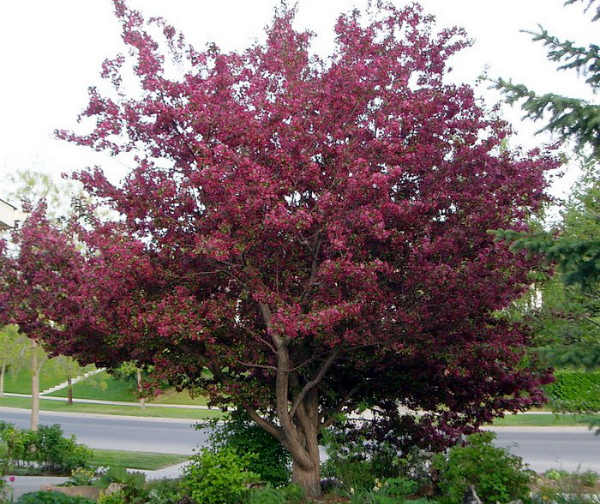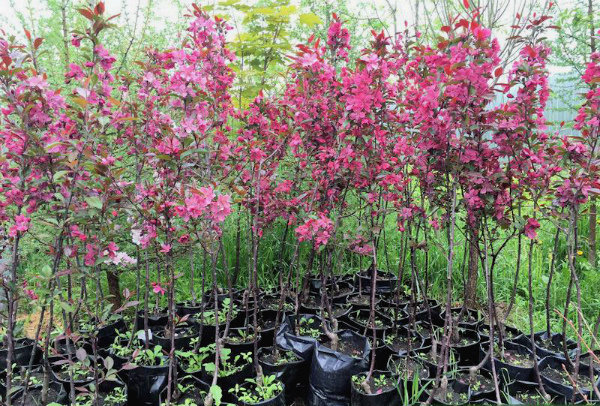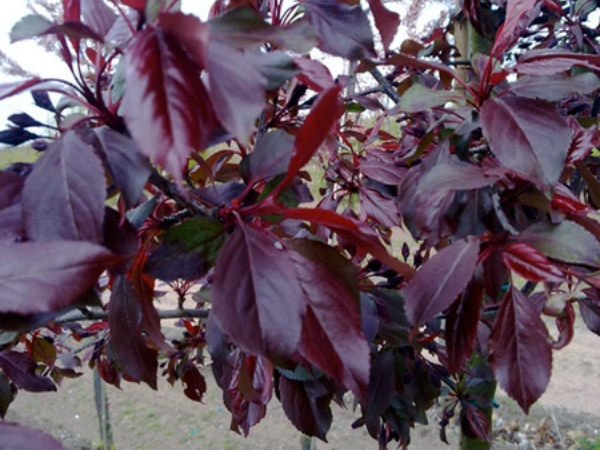Royalty is an original ornamental apple variety
Content
Description of culture
The Royalty variety is another hybrid of the famous Nedzvetsky purple apple tree, which served as the basis for breeding most types of ornamental apple trees. This amazingly beautiful tree has a rather slow growth rate. Its height is no more than 6 m, and it reaches a height of 3-4 m only by the age of 10. The crown is compact, oval in shape, reaches 4–5 m in diameter, becomes wider and rounder with age.
The tree has a luxurious decorative appearance and often takes the form of a shrub with an oval or spherical crown. The leaves are oblong, narrowed upwards, the leaf blade is glossy, slightly pubescent below, of a rich violet-red (purple) color. By autumn, the leaves become lighter and acquire a crimson hue, which does not affect their decorative effect in any way. With high foliage density, part of the crown may have a dark green color, and the other part is intense purple, but this deficiency makes the tree even more original.
The apple tree blooms very abundantly and beautifully. The flowering period occurs in early May and lasts at least 2 weeks. In the bud stage, the flowers are dark purple in color; as they bloom, they become pinkish-red, sometimes dark red. Unlike ordinary apple trees, the flowers of this variety are very large (3-4 cm in diameter), fragrant and numerous. There are so many of them that you cannot see the branches on the tree, and it seems that this is just a blooming ball. It is for this quality that the decorative apple tree is so popular with gardeners and design specialists.
The fruits of the apple tree are small (1–2 cm), round or oblong, with a deep red or purple color. The peel of apples is very dense, covered with a waxy, bluish bloom on top. The pulp is dryish, tart to the taste, not recommended for eating. The apples themselves are very tightly attached to the branches and do not lose their color for a long time. A winter tree with hanging red berries, even in severe frosts, gives the garden a special charm.
Video "Royalty is a red-leaved apple tree"
In this video, you will see what the Royalty apple tree looks like, grown in a summer cottage.
Planting and leaving
The process of planting and growing ornamental apple trees is no different from the agricultural technology of fruit varieties, we can even say that it is simpler. An ornamental apple tree is less demanding on conditions, does not need multiple feeding, and the aesthetic pleasure from it is enormous.
Like any tree, an ornamental apple tree grows best in a sunny location. But if this is not possible, the tree is ready to put up with slight shading, only in this case you need to be prepared for the fact that the color of the leaves and flowers will be less intense.
The soil for planting an apple tree needs loamy or sandy loam, moderately fertile, but well-drained, since the culture does not tolerate stagnant moisture.
All ornamental apple trees can multiply by seeds, but it is not so easy to grow a tree from seeds, therefore it is recommended to purchase seedlings for planting. When choosing a seedling with an open root system, you need to pay attention to the condition of the roots - if the roots are dry, then such an apple tree may not take root.
Immediately before planting, it is advisable to lower the purchased seedling in water for a couple of hours.
Technically, planting a tree is carried out in the same way as in the case of fruit seedlings. The size of the hole should correspond to the size of the root system of the tree - be such that the roots can be fully spread, and the seedling should be covered with earth, leaving the root collar 2-3 cm above the surface. It is not necessary to put fertilizers on the bottom of the pit, however, if desired, you can add a mineral mixture or organic matter (compost).
Trees, which are intended for landscape decoration, are usually mulched with bright colored materials to give a special decorative effect.
Apple trees of this variety are also very responsive to mulching, however, materials should be used exclusively of organic origin: sawdust, chips, tree bark, nutshells, fine gravel. Such a mulch layer will not only revive the tree, but also protect the soil from drying out.
Apple tree care is as follows:
- once a year, you need to feed it with a balanced complex fertilizer designed specifically for ornamental trees and shrubs. These products are sold in flower or gardening shops;
- watering should be done as needed (in abnormal heat conditions). Lack of moisture negatively affects the flowering and general decorative properties of the tree;
- if the soil around the trunk is not mulched, then it must be periodically loosened, weeds removed;
- sometimes it is necessary to perform crown formation. This is an optional measure, since an ornamental apple tree requires abundant flowering and a beautiful shape, and not high-quality fruits. Pruning should be very gentle, and only excess, dried or diseased branches should be removed;
- handle pests and diseases.
Yes, ornamental apple trees are susceptible to the same diseases as fruit trees (powdery mildew, scab, bacteria that cause burns), so they need to be periodically sprayed for preventive and therapeutic purposes.
Since these trees are not grown for fruit, they can be treated with broad spectrum insecticides and fungicides.
Two preventive treatments are carried out in the spring: in March, before budding begins, and in early May, before or during flowering. Autumn preventive treatment is carried out at the end of September - October.
However, these sprays can be carried out only if you definitely do not plan to eat the fruits. You need to be careful if you have small children, as brightly colored miniature apples often grab their attention. Other consumers of the fruit are birds, which can also be poisoned by toxins. In order to avoid unpleasant consequences, treatment with drugs can be carried out before the beginning of the growing season, and in the summer, sprayed with natural remedies.
Harvesting and storage
In early September, the fruits ripen on the tree. As already mentioned, they do not differ in high taste, moreover, it is believed that these fruits are inedible and can cause food poisoning. Perhaps this information is slightly exaggerated, since most varieties of "heavenly" apples are successfully used in cooking.
As for the fruits of the Royal apple tree, one cannot fail to note their diverse vitamin and chemical composition, the presence of acids, triterpenoids, which are responsible for the tart taste of apples. Of course, it is not recommended to use them fresh, but skilled housewives prepare jam, jelly, alcoholic beverages (cider, wine) from them. For these purposes, apples are removed from the tree in mid-September.
Video "Ornamental Apple Trees"
In this video you will find a story about ornamental apple trees and tips for caring for them.
Comments:
An amazing plant. Where to buy such a seedling?
Saplings of these apple trees are sold only in nurseries, and, by the way, are not cheap.
They are expensive, and there is no guarantee that this is a Royalties. I already bought one - it turned out that it is a different variety, although also decorative. Be careful - it is very difficult to determine the variety by the seedling.






